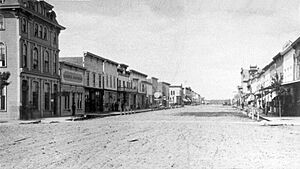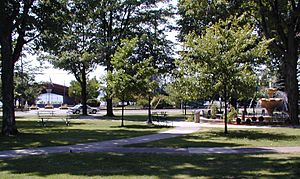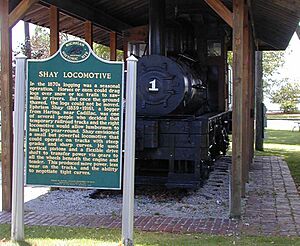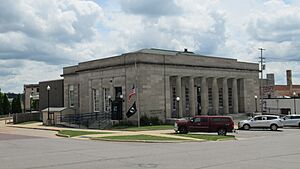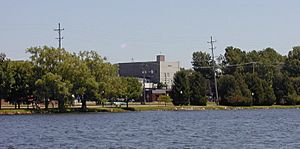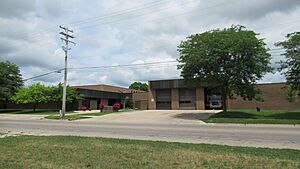Cadillac, Michigan facts for kids
Quick facts for kids
Cadillac, Michigan
|
||
|---|---|---|
| City of Cadillac | ||
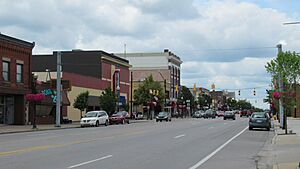
Downtown Cadillac along N. Mitchell Street
|
||
|
||
| Nicknames:
Tree City USA, City on the Lakes
|
||
| Country | ||
| State | ||
| County | Wexford | |
| Settled | 1871 | |
| Platted | 1872 | |
| Incorporated | 1875 (Clam Lake village) 1877 (city of Cadillac) |
|
| Government | ||
| • Type | Council–manager | |
| Area | ||
| • Total | 8.94 sq mi (23.16 km2) | |
| • Land | 7.08 sq mi (18.34 km2) | |
| • Water | 1.86 sq mi (4.82 km2) | |
| Elevation | 1,309 ft (399 m) | |
| Population
(2020)
|
||
| • Total | 10,371 | |
| • Density | 1,464.83/sq mi (565.56/km2) | |
| Time zone | UTC−5 (Eastern (EST)) | |
| • Summer (DST) | UTC−4 (EDT) | |
| ZIP code(s) |
49601
|
|
| Area code(s) | 231 | |
| FIPS code | 26-12320 | |
| GNIS feature ID | 1619393 | |
Cadillac is a city located in Wexford County, in the state of Michigan, USA. It is the main city of the Cadillac micropolitan area. In 2020, about 10,371 people lived here. This makes it the second-largest city in the Northern Michigan area, after Traverse City.
Cadillac was first settled in 1871. It was known as the village of Clam Lake before it became a city in 1877. The city sits on the shores of Lake Cadillac. This lake is connected by the Clam Lake Canal to Lake Mitchell. The Clam River starts in Cadillac. It flows into the Muskegon River. Cadillac is also where three main highways meet: US Highway 131, M-55, and M-115.
Contents
History of Cadillac, Michigan
How Cadillac Began: The Village of Clam Lake
European explorers and fur traders visited this area a long time ago. They came from the 1700s, mostly from France and Canada. They traded with the Native American tribes living here. Permanent towns did not start until the late 1800s. The first settlements grew from logging camps and the logging industry.
In 1871, the first sawmill opened in Clam Lake. It was called the Pioneer Mill. That same year, George A. Mitchell and Adam Gallinger started a company. They built the Clam Lake Canal in 1873. This canal connected Big and Little Clam lakes. Today, these are known as Lake Mitchell and Lake Cadillac. Sawmill owners used the canal to move timber from Big Clam Lake to their mills. The Grand Rapids and Indiana Railroad (G.R. & I. Railroad) reached the area in 1872.
The settlement of Clam Lake became a village in 1874. George Mitchell was chosen as its first mayor. The village became a city in 1877. It was renamed Cadillac. This name honored Antoine Laumet de La Mothe, sieur de Cadillac. He was a French colonist who founded Detroit in 1701.
The Battle of Manton: A County Seat Dispute
The main government office for Wexford County was first in Sherman. It moved to Manton in 1881. This happened because of a disagreement between Cadillac and Sherman. But Cadillac residents voted in April 1882 to bring the county seat to Cadillac.
The day after the vote, a group from Cadillac went to Manton. They traveled by special train to get the county records. They collected some papers, but an angry crowd stopped them. The Cadillac men had to leave town. When the sheriff returned to Cadillac, he gathered a large group of armed men. They went back to Manton to get the rest of the records. Manton residents tried to block them, but the Cadillac group succeeded. They brought the documents back to Cadillac.
Cadillac Grows and Changes
In 1878, Ephraim Shay improved his Shay locomotive. This train engine was great for climbing hills and turning sharp corners. Cadillac was home to the Michigan Iron Works Company. They made the Shay locomotive for a short time in the early 1880s. The lumber industry was very important in Cadillac. Many immigrants, especially from Sweden, came to work in the lumber mills. Later, Cadillac became sister cities with Mölnlycke, Sweden, and Rovaniemi, Finland.
By the early 1900s, most of the trees were cut down. The timber industry started to decline. Today, many people in Cadillac work in manufacturing. Cadillac makes things like boats, car parts, and vacuum cleaners.
In 1936, the U.S. Forest Service and the Civilian Conservation Corps built the Caberfae Ski Area. This was during the Great Depression. It helped the area grow as a tourist spot. Caberfae is still open today. It is the oldest ski resort in the Midwest. Tourism and outdoor fun are now a big part of Cadillac's economy.
In summer, people visit for boating, fishing, and hiking. In fall, hunting and color tours are popular. Winter is often the busiest time. Many people come for skiing, ice-fishing, and snowmobiling. The North American Snowmobile Festival (NASF) happens on frozen Lake Cadillac every winter.
A gas station near Cadillac used to have a brown bear named Samantha, or "Sam." She lived there from the 1970s to the late 1990s. Sam was special because she was the only captive brown bear in the US at the time to hibernate naturally. Tourists would feed her ice cream cones.
In October 1975, the rock band Kiss visited Cadillac. They played a concert at Cadillac High School. They did this to honor the school's football team. The team had been losing games. Their assistant coach, Jim Neff, played Kiss music to inspire them. He also connected the team's game plan, "Keep It Simple Stupid" (K-I-S-S), to the band's name. The team then won seven games in a row. When Kiss heard about this, they visited the school and played for the homecoming game.
Geography and Landscape
The city of Cadillac covers about 9.02 square miles (23.36 square kilometers). About 7.16 square miles (18.54 square kilometers) is land. The rest, 1.86 square miles (4.82 square kilometers), is water.
The 1,150-acre (4.7 km²) Lake Cadillac is completely inside the city. The larger, 2,580-acre (10.4 km²) Lake Mitchell is nearby. The two lakes are connected by the Clam Lake Canal. This canal was built in 1873. A strange thing about the canal is that it freezes before the lakes in winter. Then, after the lakes freeze, the canal thaws and stays unfrozen. This was even shown on Ripley's Believe It or Not!
Cadillac is on the edge of the Manistee National Forest. The area around Cadillac has many trees. It has mixed hardwood and conifer forests. Christmas tree farming is also important here. In 1988, Cadillac was chosen to provide the holiday tree for the U.S. Capitol building in Washington, D.C. The area around Cadillac is mostly rural. Cadillac is a main business and industry center for the region.
City Layout: What Cadillac Looks Like
The main part of the city is on the east side of Lake Cadillac. Most buildings downtown are two to five stories tall. Many are on Mitchell Street, which is the city's main street. Downtown has a movie theater, shops, restaurants, and other businesses.
The Courthouse Hill Historic District is next to the downtown area. It has many large Victorian-style homes. These were built by wealthy lumber owners and business people in the 1870s. This area has the most people and buildings.
On the west side of Lake Cadillac is Cadillac West. This is a small shopping area. It is near Mitchell State Park and the two lakes. It has many motels and restaurants for tourists. The areas along the north and south of the lake are mostly homes. They have single-family houses.
Cadillac's Climate: Weather in Michigan
Cadillac has a typical northern Michigan climate. It has four distinct seasons. The nearby Lake Michigan affects the weather, especially with lake effect snow. Winters are usually cold with lots of snowfall. Summers are warm. The average high temperature in July is 80°F (27°C). The average low in January is 12°F (-11°C). Summer temperatures can go above 90°F (32°C). Winter temperatures can drop below 0°F (-18°C). Cadillac gets about 30 inches (76 cm) of rain each year. It gets about 81 inches (206 cm) of snow each year. Snow usually falls from November to March.
Population and People
Cadillac had 10,371 people living there in 2020. The city is home to people from many backgrounds. In 2010, about 95.6% of residents were White. About 1.8% were Hispanic or Latino. The average age in the city was 36.5 years. About 24.7% of residents were under 18 years old.
Economy: How Cadillac Makes a Living
Manufacturing is the biggest employer in Cadillac. It has been since the logging industry ended. More than 26% of the city's workers are in manufacturing. Cadillac has three industrial parks. These parks make up 7% of the city's land. They also bring in 47% of the city's taxes. The local industries greatly affect Cadillac's economy.
The city center feels like a "small town." In summer, many tourists visit downtown. They often come from southern Michigan. The city center is very close to Lake Cadillac. Visitors can easily reach it by boat or car. Cadillac is near two lakes, the Manistee National Forest, and major highways. This has made tourism a very important part of the local economy.
In winter, Lake Cadillac and Lake Mitchell freeze. The city gets covered in snow. Cadillac is connected to many trails for winter fun. Snowmobilers especially enjoy these trails.
Cadillac is also known as Chestnut Town, USA. Many American chestnut trees grow here. Pioneers from New York and Pennsylvania planted them. A disease in the early 1900s killed most American Chestnut trees. But those in western Michigan developed a special resistance and survived.
Main Employers in Cadillac
Here are some of the biggest employers in Cadillac:
- Avon Automotive
- Cadillac Area Public Schools
- Four Winn's/Glastron/Wellcraft/Rec Boat
- Avon Protection Systems
- Cadillac Casting
- Munson Healthcare Cadillac Hospital
- Rexair
- AAR Mobility Systems
- Michigan Rubber Products
- Fiamm Technologies
Arts and Culture
Cadillac has several places with Michigan historical markers. These include the Cadillac Carnegie Library, the Charles T. Mitchell House, the Clam Lake Canal, and the Shay Locomotive.
Education: Schools in Cadillac
Cadillac's public school system has 10 schools. About 3,100 students attend these schools. There are about 166 teachers. This means there are about 19 students for every teacher. Cadillac also has 4 private schools. About 394 students attend these schools.
Cadillac Area Public Schools
The public schools are managed by Cadillac Area Public Schools. The city has two high schools: Cadillac High School and Innovation High School. There is also Mackinaw Trail Middle School for grades 6, 7, and 8. The three elementary schools are Forest View, Franklin, and Lincoln. The Viking Learning Center is for early childhood education. Cadillac also has an alternative high school.
Private Schools in Cadillac
- Cadillac Heritage Christian offers Christian education for students from pre-kindergarten to 12th grade.
- Northview Adventist School had 16 students in grades 1–10 in 2020.
- St. Ann School is a private Roman Catholic school. It has 236 students in grades pre-kindergarten to 7.
Training Schools
- Northwoods Aviation at Wexford County Airport teaches people how to fly and fix aircraft.
- The Cadillac Institute of Cosmetology is a salon that teaches cosmetology. High school students can attend through a partnership with Wexford-Missaukee Intermediate School District.
Colleges in the Area
The Baker College-Cadillac campus is just outside the city. It covers 66 acres (27 hectares). Over 1,300 students attend this school. It offers Associate's and Bachelor's degrees, plus special certifications.
Media: News and Entertainment
Newspapers
- The Cadillac News
Radio Stations
- WATT (1240 AM) – news and talk
- WLJW (1370 AM) – religious
- WOLW (91.1 FM) – religious "Northern Christian Radio"
- WGCP (91.9 FM) – religious Strong Tower Radio
- WJZQ (92.9 FM) – Top 40 "Z-93"
- WKAD (93.7 FM) – "The Ticket" (Fox Sports Radio)
- WLXV (96.7 FM) – 96.7 The Bull
- WAIR (104.9 FM) – contemporary Christian "Smile-FM"
- WCKC (107.1 FM) – classic rock "The Drive"
- WCDY (107.9 FM) – hot AC "107.9 CDY"
Television Stations
- WWTV (Channel 9) – CBS, known as "9 &10 News"
- WMNN (Channel 26) – ShopHQ
- WCMV (Channel 27) – PBS, a satellite of WCMU in Mount Pleasant, Michigan
- WFQX (Channel 32) – Fox, known as "Local 32"
- WFQX-DT2 (Channel 32.2) - The CW Plus, known as "The CW Northern Michigan"
- W23EB-D (Channel 23.1-23.7) - 3ABN, Amazing Facts TV, Strong Tower Radio
Infrastructure: Getting Around Cadillac
Major Highways
Cadillac is where three highways meet: US 131, M-55, and M-115.
 US 131 goes around the east side of the city. It continues south towards Big Rapids and Grand Rapids. North of Cadillac, it becomes a two-lane highway to Petoskey.
US 131 goes around the east side of the city. It continues south towards Big Rapids and Grand Rapids. North of Cadillac, it becomes a two-lane highway to Petoskey.


 Bus. US 131 is a loop route through downtown. It follows the old path of US 131. In the city, it is called Mitchell Street, after George Mitchell.
Bus. US 131 is a loop route through downtown. It follows the old path of US 131. In the city, it is called Mitchell Street, after George Mitchell. M-55 is a main two-lane road that crosses the state from east to west. It connects to Manistee in the west and Lake City in the east.
M-55 is a main two-lane road that crosses the state from east to west. It connects to Manistee in the west and Lake City in the east. M-115 is another main two-lane road. It runs diagonally from Clare in the southeast to Frankfort in the northwest.
M-115 is another main two-lane road. It runs diagonally from Clare in the southeast to Frankfort in the northwest.
Trains
The city has train service from the Great Lakes Central Railroad. This is mainly for moving goods. Passenger service might be available in the future.
Public Transportation
- Cadillac and Wexford County share a local bus service. The Wexford Transit Authority has been running since 1974. It is a bus system where you can call for a ride.
- Indian Trails offers daily bus service between Grand Rapids and St. Ignace. It makes a stop in Cadillac.
Trails for Walking and Biking
The northern end of the White Pine Trail is in Cadillac. This trail is 92 miles (148 km) long. It starts in Comstock Park and follows an old railroad track into the city. The trail is paved for 16 miles (26 km) from Leroy north to Cadillac.
Notable People from Cadillac
- Jim Bowman, an NFL football player.
- Jan Harold Brunvand, an American folklorist, was born in Cadillac.
- Larry Joe Campbell, an actor from the show According to Jim, was born in Cadillac.
- George A. Mitchell, known as the founder of the city of Cadillac.
- Jackie Swanson, an actress from Cheers, went to high school in Cadillac.
- Guy Vander Jagt, a U.S. congressman, was born in Cadillac.
- Luke Winslow-King, a musician, was born in Cadillac.
- Ad Wolgast, a professional boxer, was born in Cadillac.
- Paul McMullen, a middle-distance runner, grew up in Cadillac.
See also
 In Spanish: Cadillac (Míchigan) para niños
In Spanish: Cadillac (Míchigan) para niños



